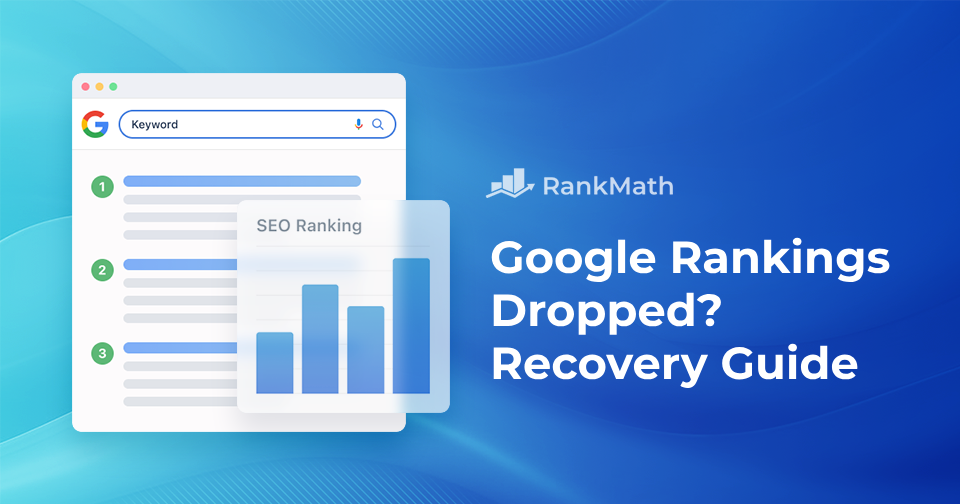Has your website suddenly dropped in Google rankings, and you’re left wondering what went wrong?
You’re not alone.
But here’s the good news: with the right approach, you can figure out what caused the drop and take steps to fix it.
In this post, we’ll discuss the most common reasons rankings fluctuate and, more importantly, a step-by-step process to identify and resolve the issues behind your Google rankings drop.
So, without any further ado, let’s get started.
Table Of Contents
- Assess the Severity of the Drop
- Evaluate Google’s Algorithm Updates
- Check for Technical Issues
- Analyze Content Updates and Changes
- Answer Related User Questions
- Check Competitor’s Ranking
- Audit Backlinks and Link Profile
- Check the SERPs
1 Assess the Severity of the Drop
When your Google rankings take a hit, the first thing you need to do is figure out how bad the drop really is. A clear assessment helps you understand the scope of the problem and guides your recovery efforts.
Start by checking tools like Google Analytics and Google Search Console. These platforms can show you exactly how your traffic and keyword rankings have changed.
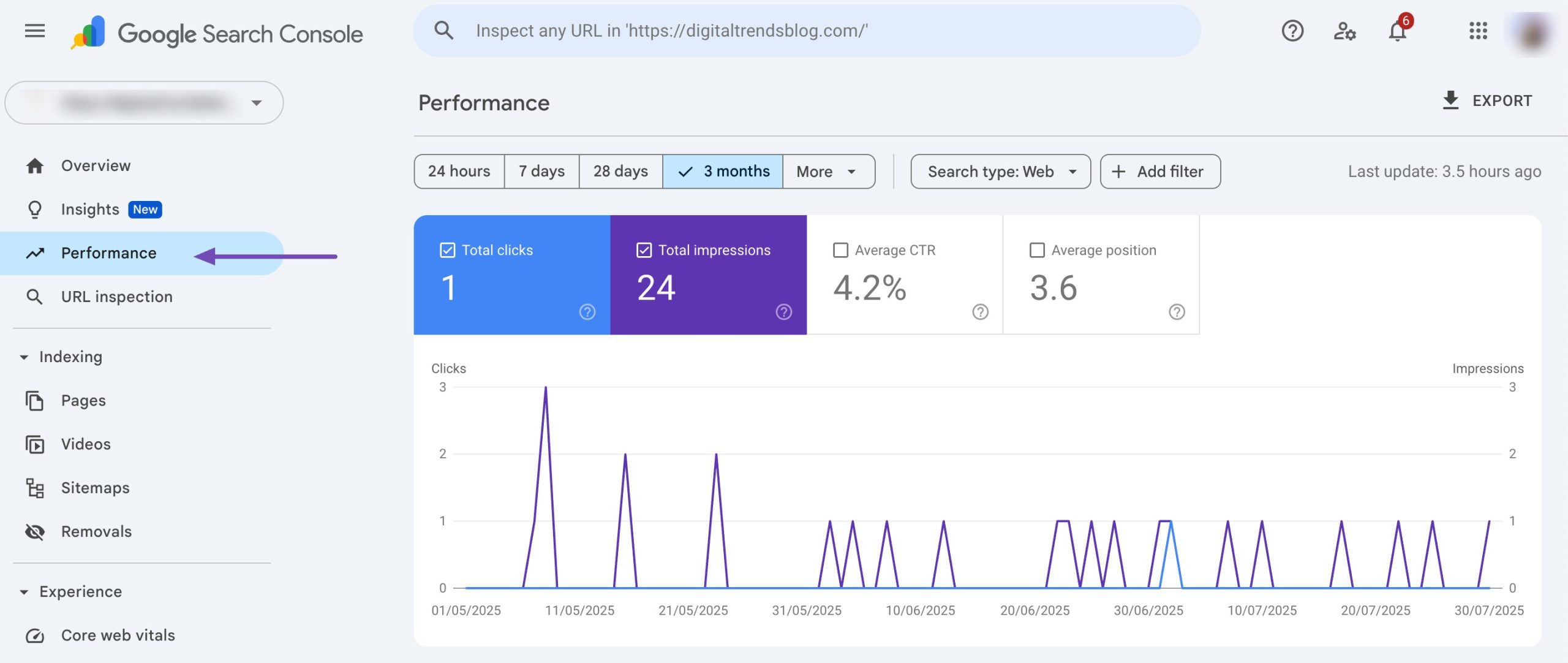
Look for:
- Which keywords lost visibility
- Which pages or sections of your site were most affected
This will help you zero in on the problem areas instead of making unnecessary changes to parts of your site that are still performing well.

Next, ask yourself: Did the drop happen overnight or was it gradual?
- A sudden drop often points to something specific, like a Google algorithm update, a technical glitch, or a penalty.
- A gradual decline, on the other hand, may indicate deeper issues, such as declining content quality, slow site speed, or outdated SEO tactics.
Recognizing the pattern makes it easier to tell whether you’re dealing with a short-term fluctuation or a more serious issue that needs a long-term fix.
2 Evaluate Google’s Algorithm Updates
If your rankings suddenly dropped, one of the first things you should check is whether a Google algorithm update is behind it.
Google regularly rolls out updates to improve search quality and deliver more relevant, trustworthy content to users. These updates can have a major impact on your site’s visibility, so understanding them is key to taking the right recovery steps.
Start by keeping an eye on official Google announcements and reliable SEO news sources. Updates like Core Updates, Product Review Updates, and Spam Updates are known to shake up the rankings for many sites.
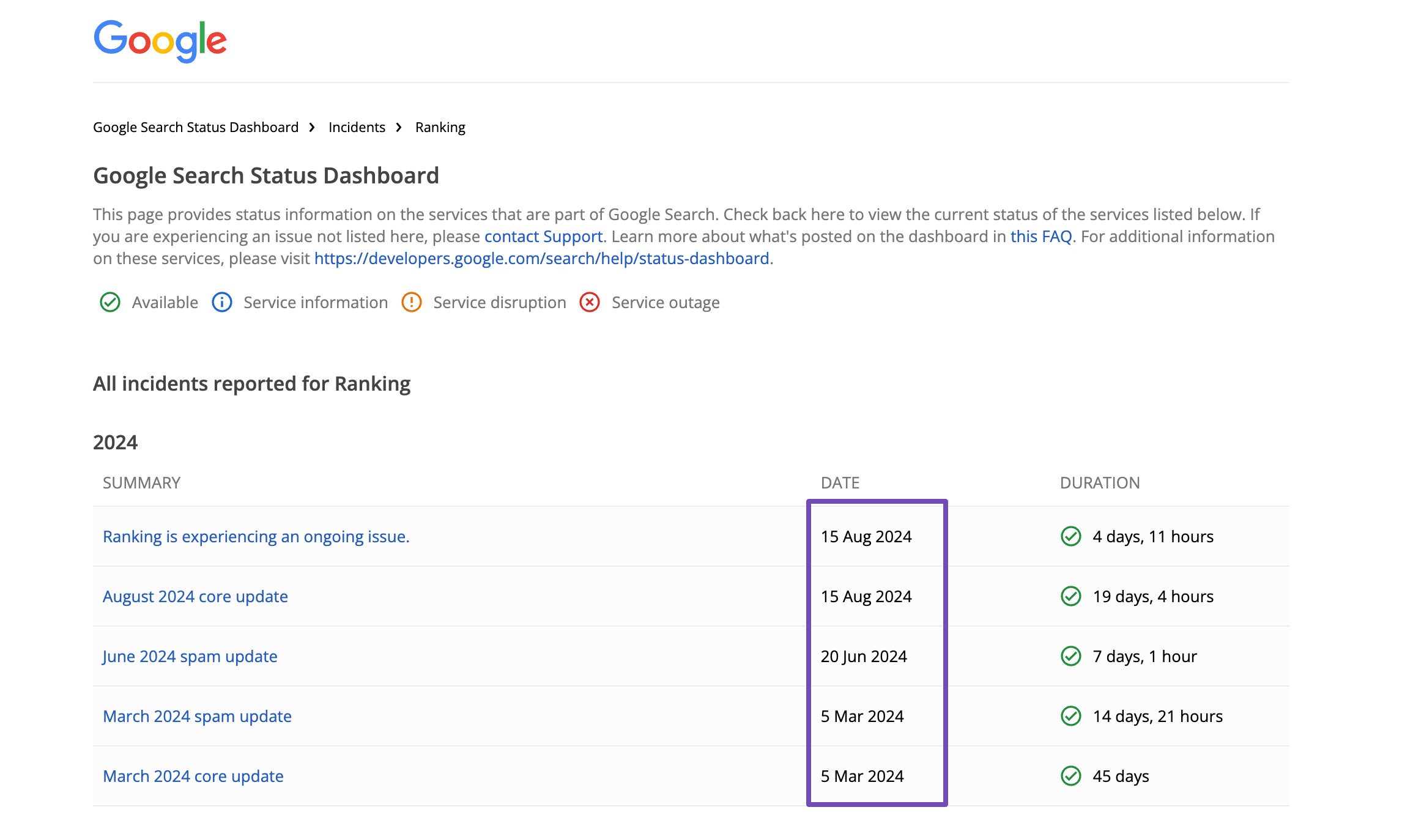
To make this easier, Rank Math actually integrates Google’s update timeline directly into your Analytics graphs. That means you can instantly see if a drop in traffic lines up with an algorithm change, no more second-guessing.
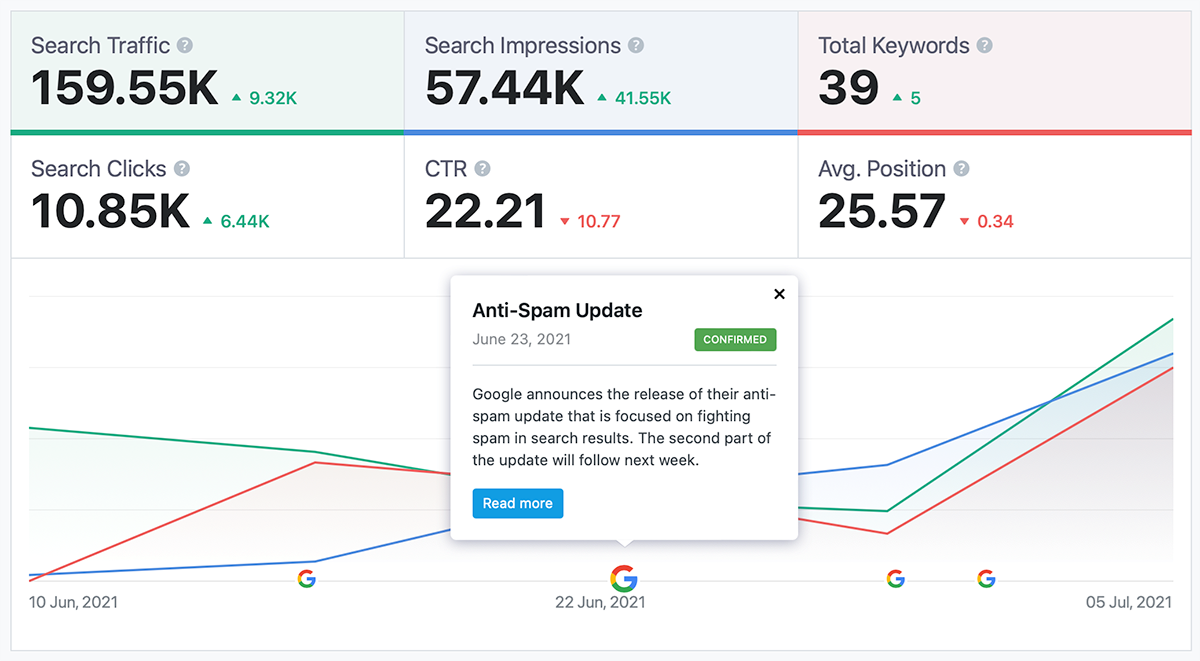
You can also check our Google Updates page to stay on top of any new changes and understand how they might be affecting your site.
3 Check for Technical Issues
If your Google rankings have dropped, it’s important to review any recent changes to your site. Even small tweaks, like a plugin update or code change, can have a big impact on your SEO performance.
Technical SEO forms the backbone of your website’s visibility. In fact, 98% of people agree that website performance matters, with 45% citing better rankings, 24% noting lower bounce rates, and 21% pointing to higher conversions as key benefits of faster-loading sites.
Start by checking for common technical issues like:
Use Google Search Console to identify these problems quickly. If Google can’t access or crawl your pages properly, your rankings will suffer.
Next, review your mobile usability and Core Web Vitals, especially if you’ve recently redesigned your site or rolled out major updates.
Core Web Vitals focus on:
- Page speed
- Interactivity
- Visual stability
If your pages are loading slower or are difficult to use on mobile, fixing those issues should be a top priority. These are direct ranking signals that affect both user experience and SEO.
Also, if certain pages lost rankings, make sure they’re still indexed. Do a quick check by searching site:yourdomain.com in Google to confirm which pages are visible to search engines.
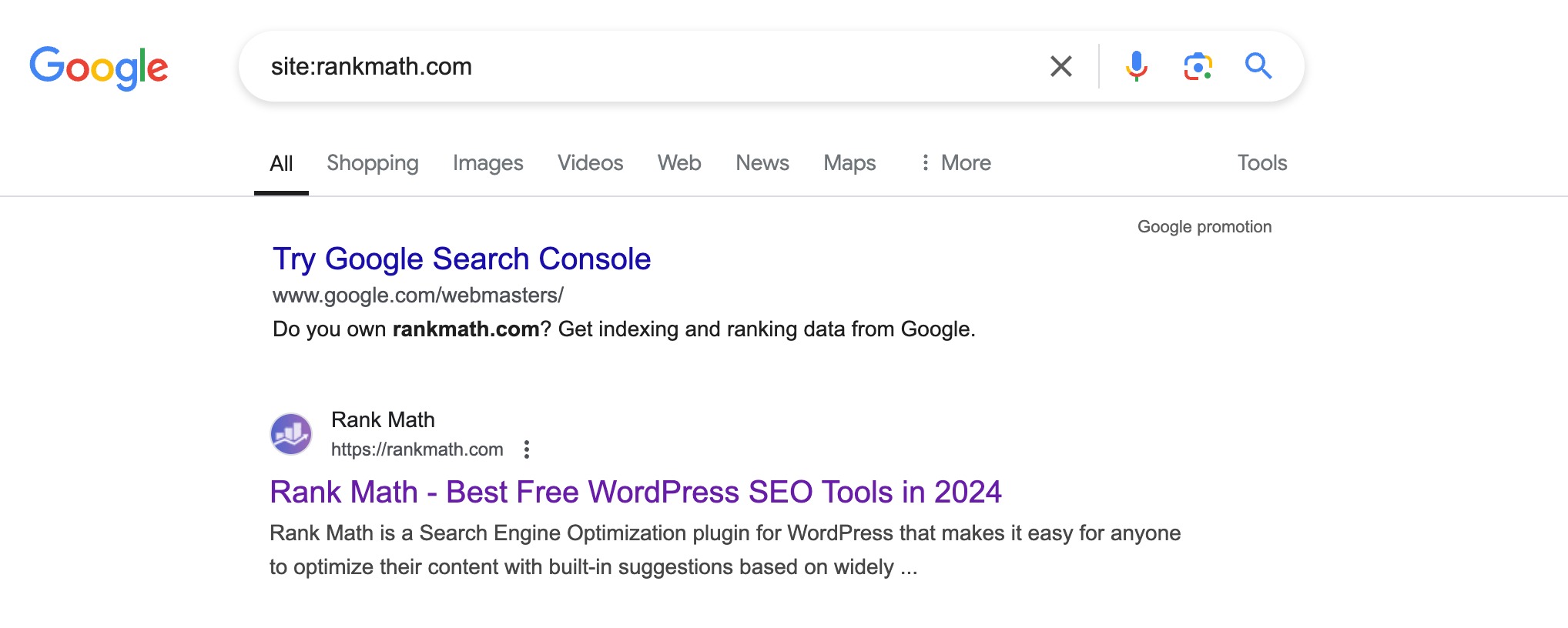
Then, log into Google Search Console and look for:
- Indexing errors
- Noindex tags
- Blocked resources in robots.txt
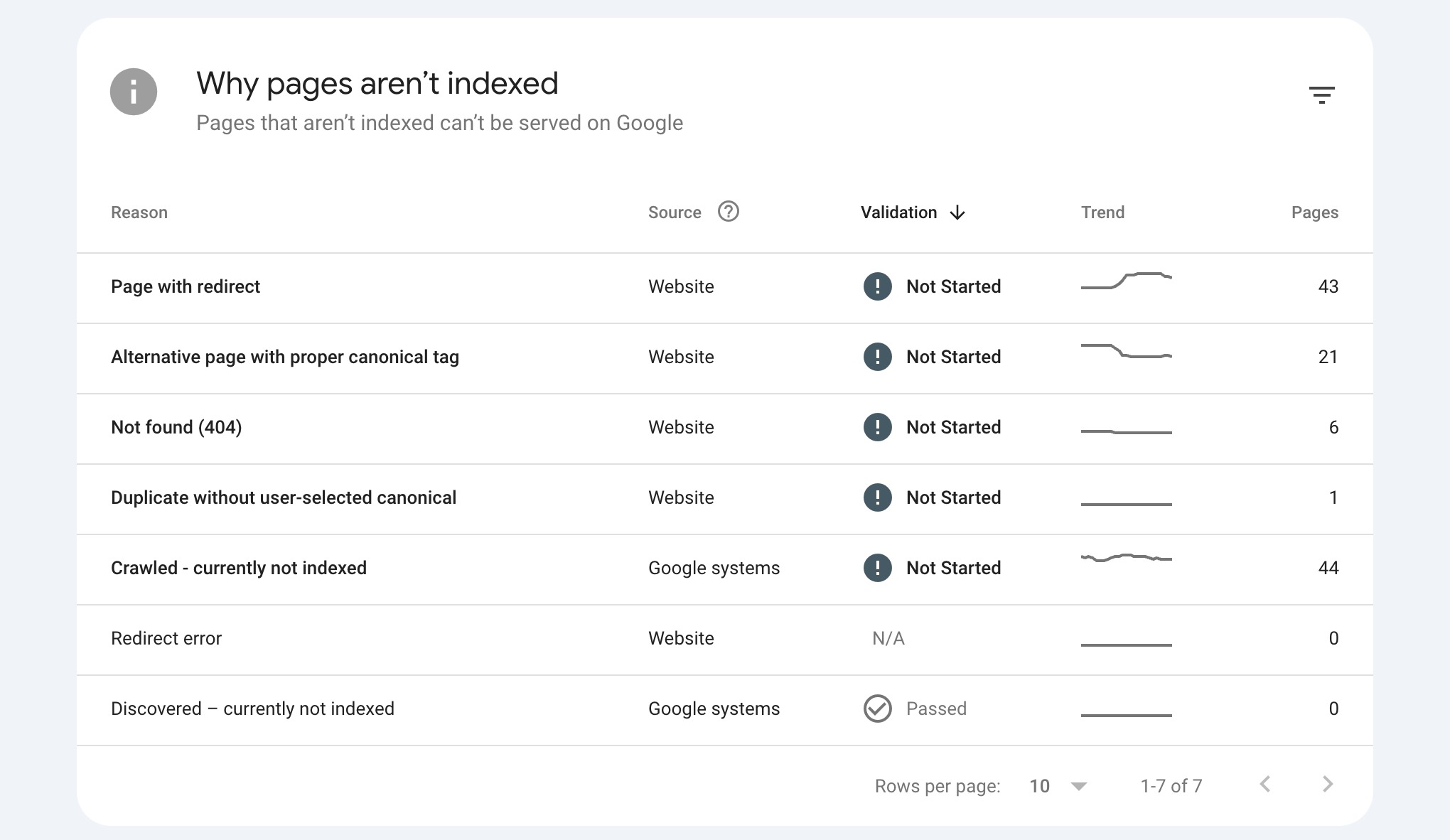
If Google can’t crawl or index your content, it can’t rank it. Fixing these issues can help restore your rankings.
Refer to our dedicated tutorial on technical SEO to identify and solve the issues and recover from the drop in rankings.
4 Analyze Content Updates and Changes
Content updates can absolutely cause your rankings to shift, sometimes for better, sometimes for worse. If you’ve noticed a drop, take a moment to review any recent changes you or your team made to your content.
Start by asking yourself:
- Was any important content removed or rewritten?
- Did you duplicate content across multiple pages?
- Were key sections, like product details or expert insights, unintentionally watered down?
Even small changes can affect the relevance and authority of your content in Google’s eyes.

You should also take a closer look at the structure and formatting of the content. Changes to things like:
…can all influence how well Google understands and ranks your page. What might seem like a minor content cleanup could actually weaken your SEO if best practices weren’t followed.
Make sure your updates are still aligned with good on-page SEO, readability, and keyword targeting.
Most importantly, optimize your content for E-E-A-T: Experience, Expertise, Authoritativeness, and Trustworthiness.
Google heavily factors E-E-A-T when evaluating content quality, especially for YMYL (Your Money or Your Life) topics.
Optimizing for E-E-A-T can improve your site’s credibility, strengthen its rankings, and increase user intent.
Refer to our dedicated tutorial on E-E-A-T strategies to learn how to strengthen your content and improve your chances of ranking higher.
5 Answer Related User Questions
When your site takes a hit in Google rankings, one of the smartest ways to bounce back is by better addressing user intent, and a great strategy for that is answering related user questions directly within your content.
Start by using Google’s “People Also Ask” (PAA) feature. Type in your primary keyword, for example, Why did my Google rankings drop?, and take note of the questions that appear. As you click on each one, even more related queries will appear, giving you deeper insight into what your audience wants to know.
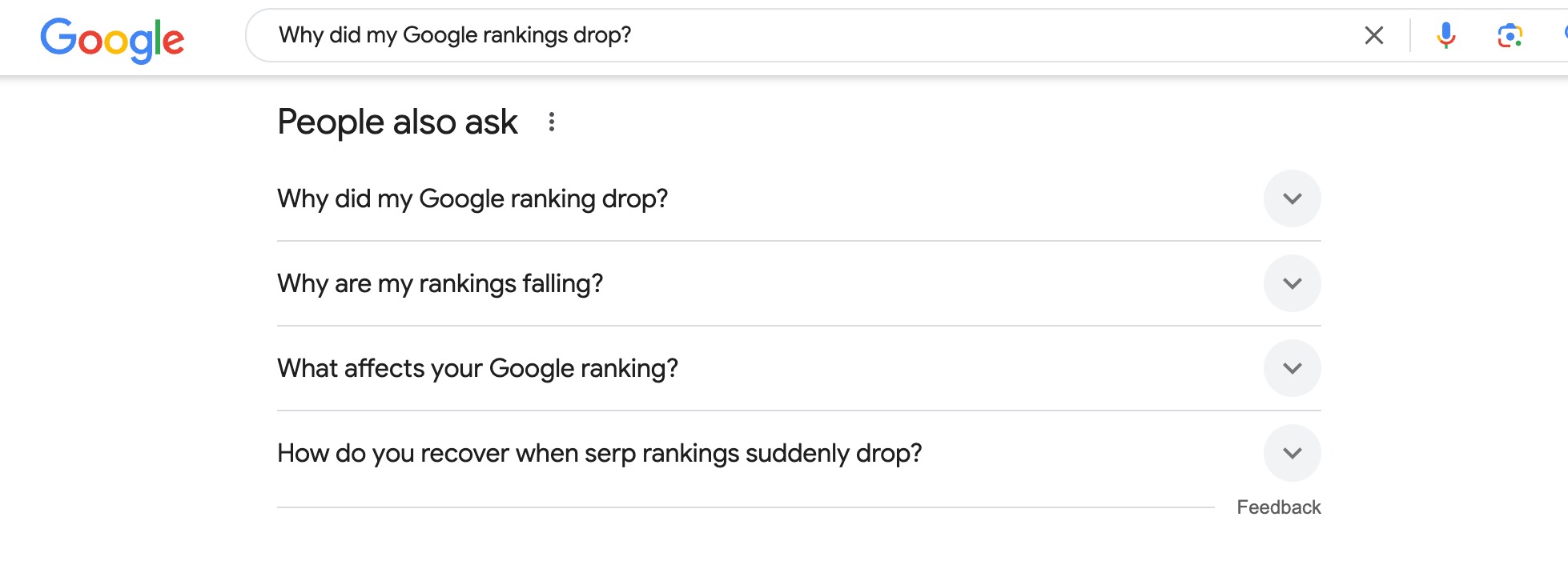
You can also use Google Autocomplete. As you start typing your keyword into the search bar, it will show popular questions and phrases users are actively searching for.
Once you’ve gathered the most relevant questions, weave them naturally into your content. One of the easiest and most effective ways to do this is by adding an FAQ section at the end of your article.
Rank Math makes adding an FAQ section to your post or page extremely easy.
To do so, click the plus icon on the right of the content area to add a block.
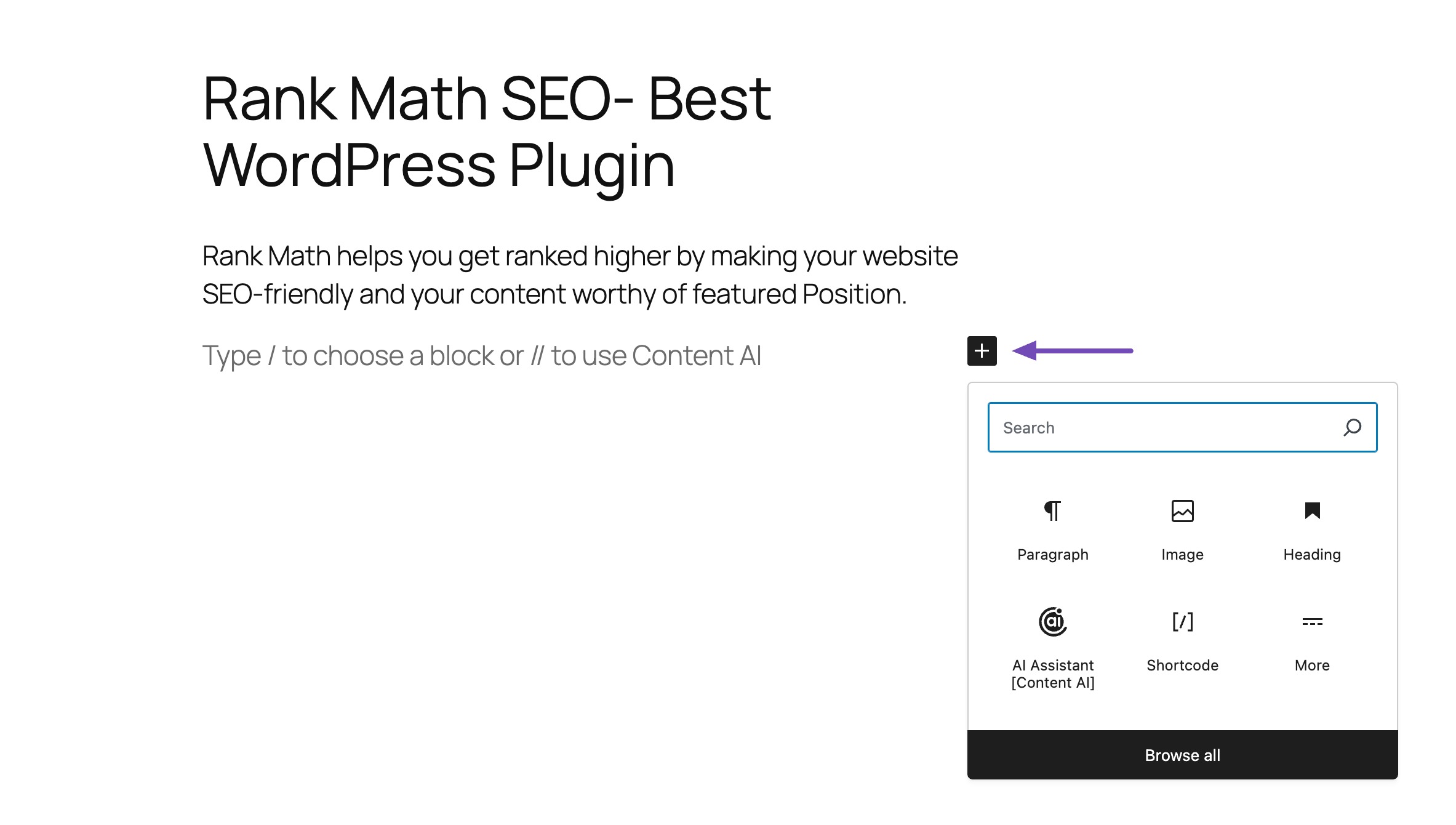
Next, choose the FAQ Block by Rank Math, as shown below.
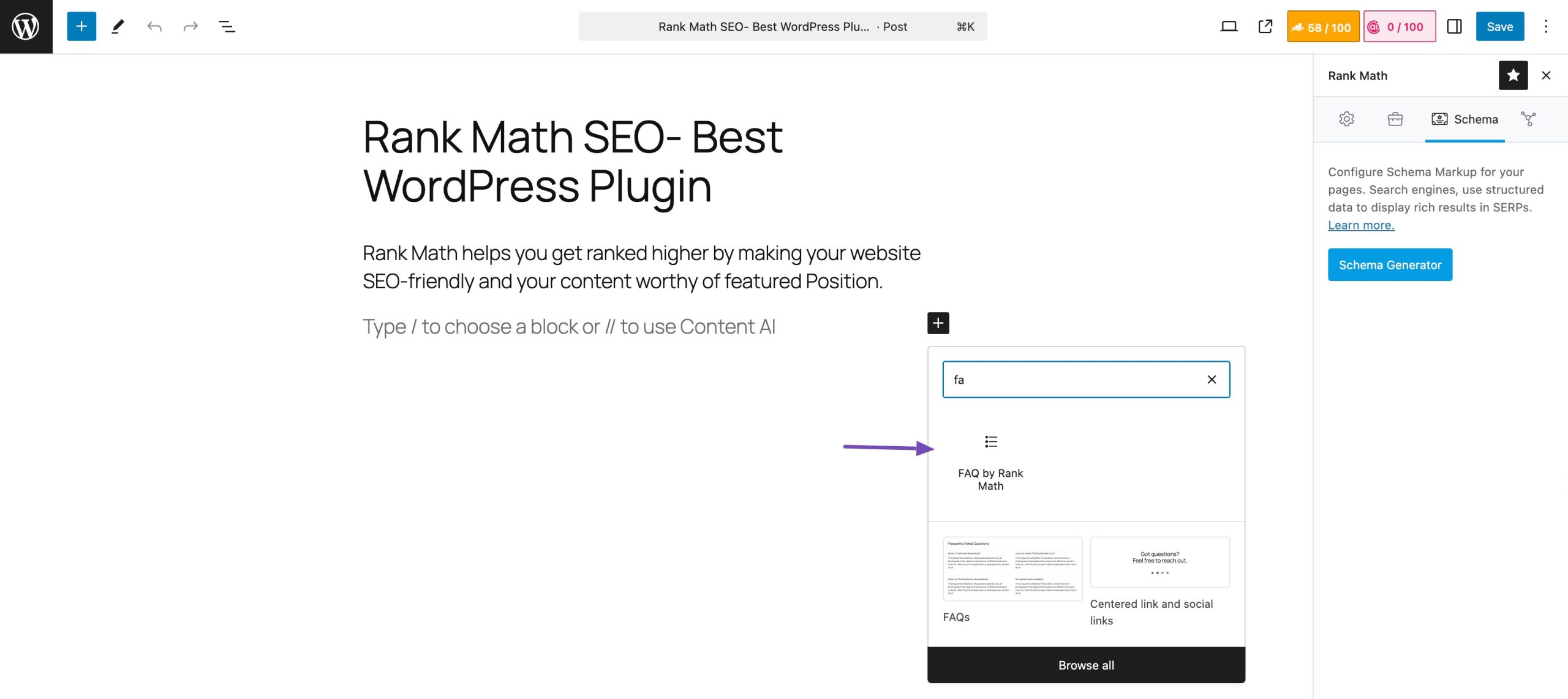
Once done, you’ll be able to easily insert the question text and the answer content to that question, respectively, and an image.
Even better, use Rank Math’s Content AI to speed things up. Just click the AI icon within the FAQ block, and let Content AI generate well-optimized answers based on your topic.

6 Check Competitor’s Ranking
If your Google rankings have dropped, don’t just look inward; take a good look at what your competitors are doing too. Analyzing their performance can give you valuable context and help you spot opportunities to improve.
Start by listing your direct competitors, those ranking for the same keywords and targeting the same audience. These are the sites you’re up against in search results, and tracking their movement can help you understand whether your drop is part of a larger trend or something specific to your site.

Use SEO tools like Semrush or Ahrefs to:
- Monitor your competitors’ keyword rankings
- Track the performance of their top pages
- Identify any recent ranking trends
If you notice that competitors are also losing rankings, it might point to a broader issue, like a recent Google algorithm update. But if they’re holding steady or gaining while you’re dropping, that’s a sign you need to dig deeper into your own site.
Pay close attention to:
- Content updates they’ve made
- New backlinks they’ve earned
- Changes in UX or site structure
- Better on-page optimization
These details can give you ideas for what’s working right now in your niche and where your site might be falling behind.
Refer to our dedicated tutorial on competitive analysis to boost your rankings.
7 Audit Backlinks and Link Profile
Backlinks are one of the biggest factors in how Google ranks your website, but not all links are good for you. In fact, spammy or irrelevant backlinks can actually hurt your rankings.
If you’ve seen a drop, it’s time to audit your link profile.
Start by using tools like Ahrefs or Semrush to scan your backlinks and identify any toxic or low-quality links. Look for links coming from:
- Spammy or suspicious websites
- Irrelevant sources that have nothing to do with your niche
- Sites with low domain authority or a history of bad SEO practices
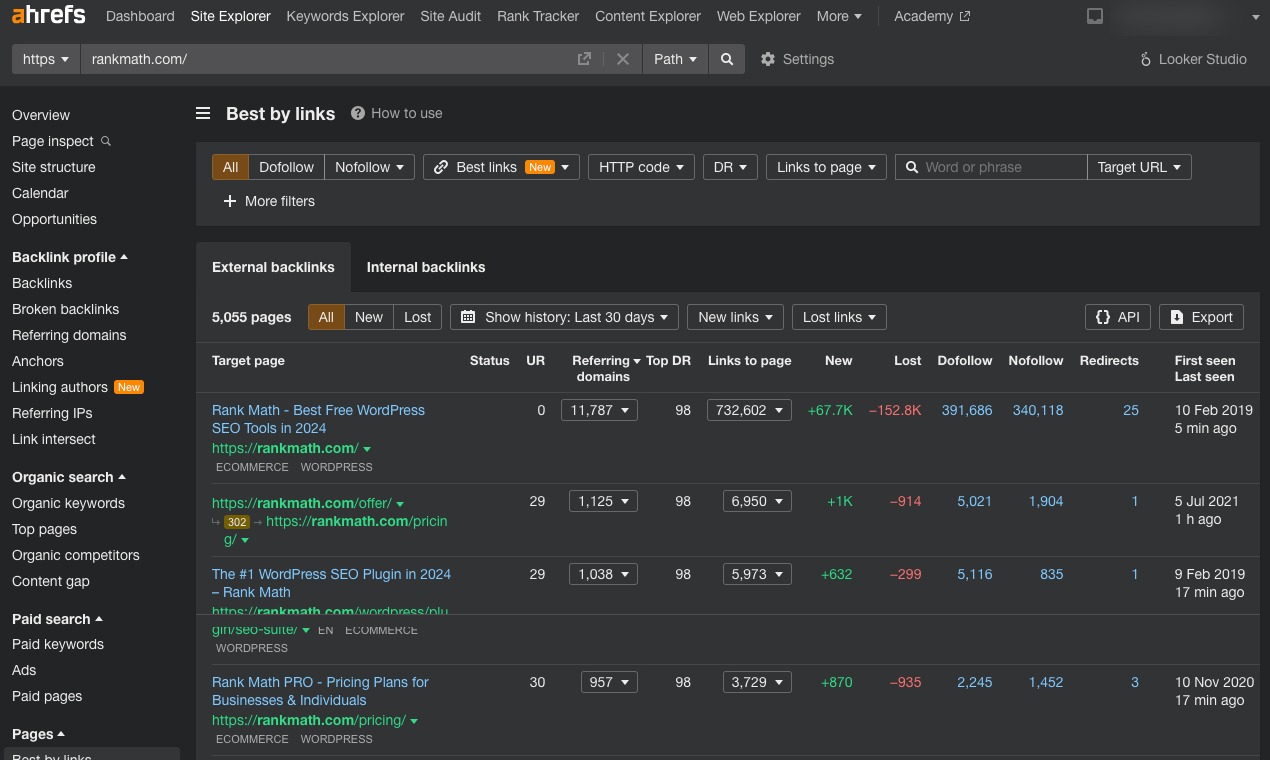
These kinds of links can trigger penalties or simply weaken your site’s trustworthiness in the eyes of search engines.

Once you’ve cleaned up the harmful links (you may need to disavow them if necessary), focus on building a high-quality backlink profile. This means earning links from trustworthy, relevant sites that actually add value.
Here are a few proven strategies:
- Guest post on reputable blogs in your niche
- Collaborate through content partnerships
- Create valuable, shareable content that naturally earns backlinks
A strong, clean link profile boosts your site’s authority and can play a key role in recovering lost rankings.
Refer to our dedicated tutorial on link building to improve your link profile and further help you recover from the drop in Google rankings.
8 Check the SERPs
When your rankings drop, one of the first places you should look is the Search Engine Results Pages (SERPs) for your target keywords. The SERPs can reveal a lot about why your content may no longer be hitting the mark.
Take a close look at what’s currently ranking at the top. Has the search intent changed?
Maybe Google is now favouring product pages, videos, or how-to guides instead of blog posts. If your content doesn’t match what users are looking for anymore, that could be the reason for your drop in Google rankings.
Rank Math PRO makes this easier with its Search Intent feature. Just click the Show Intent button next to your primary keyword, and you’ll instantly see whether it’s informational, transactional, navigational, or commercial. This insight helps you realign your content with what Google expects.
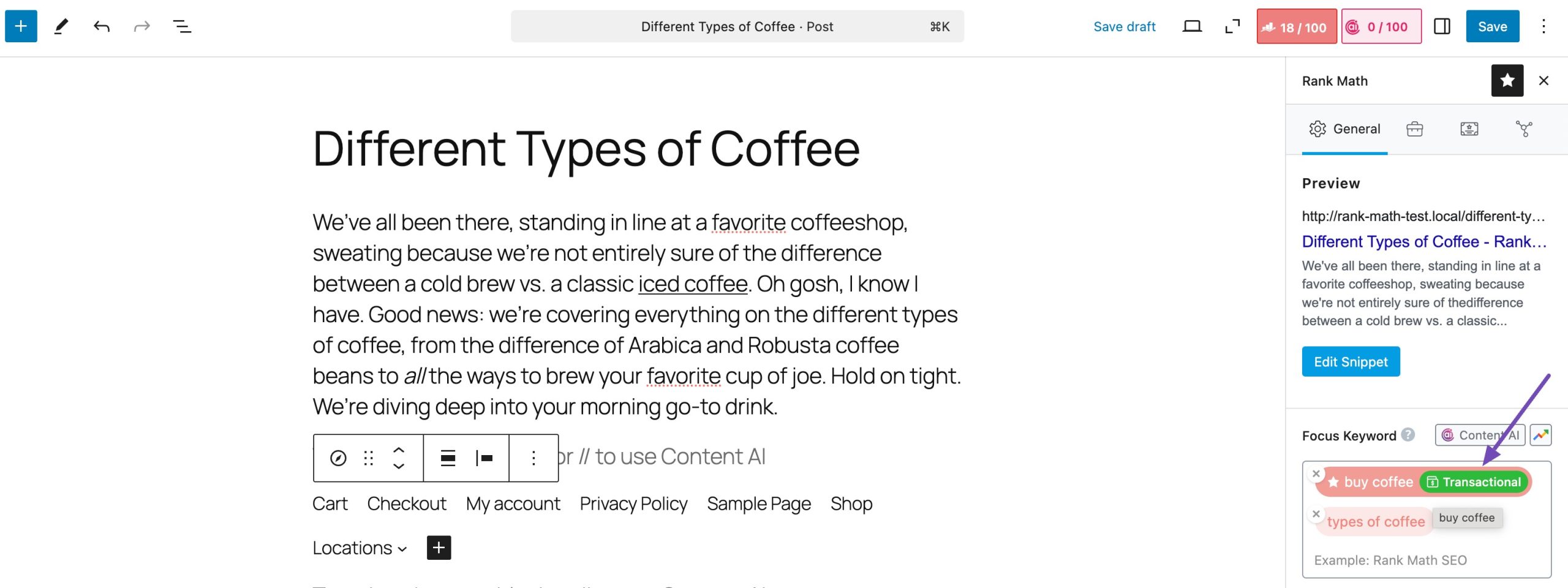
Also, pay attention to SERP features like:
- Featured snippets
- People Also Ask boxes
- Image carousels
- Video results
These elements often take up prime real estate and can dramatically lower your click-through rates even if your page hasn’t technically lost rank.
To compete, consider optimizing your content for these features:
- Use clear, concise answers for common questions
- Structure your content with proper headings (H2, H3)
- Add visuals or video content where appropriate
Wrapping Up: Recovering From Google Rankings Drop
Seeing your Google rankings drop can be stressful, but it’s not the end of the road. With the right approach, you can figure out what went wrong and take clear, actionable steps to bounce back.
Remember, ranking fluctuations happen to every site at some point. It’s a normal part of the SEO journey.
What matters is how you respond. By regularly monitoring your site’s performance, staying updated with algorithm changes, and consistently creating high-quality, relevant content, you’ll strengthen your SEO and build long-term resilience.
Take a strategic, data-driven approach, and you won’t just recover, you’ll set yourself up for even better search performance moving forward.
If you like this post, let us know by tweeting @rankmathseo.
